There are few objects in the gardening world with the iconic status of a clay pot. The phrase terra cotte can be literally translated from the Italian as “fired earth”. Clay is a type of dense mineral soil characterized by a reluctance to drain, and a sticky texture. Never mind the science-every gardener knows what it is to plant into heavy clay soil. Backbreaking. Firing clay – slowly heating it for an extended period to a very high temperature – results in physical and chemical changes that are irrevocable. Fired earth makes objects of great service, from drain and roofing tiles to garden pots. The fired earth is porous, meaning it will both absorb and give up water. Why is it that a plant in a clay pot will dry out in the blink of an eye, when my clay based soil holds its water forever? I do not know the answer to this, but I do know the porous quality of terra cotta pots is friendly to the development of good strong roots. Container grown plants thrive in clay pots.
Some of the earliest clay pots in Italy were used to store olive oil. This shape exists to this day. Modern clay pots are manufactured in several ways. Machine formed terra cotta-I have lots of those ubiquitous 8″ diameter pots. I have bought myrtle topiaries, dahlias, and lavender planted in them. They come in an astonishing range of sizes-from bulb pans to azalea pots to long toms-love them all. They are a symbol and a tool for growing. These pots are inexpensive-they are mass produced, and fired at a fairly low temperature. Knock one over and it will break. A machine made terra cotta pot left outdoors over our winter will absorb water from the ground and air. When the water in the clay freezes, it expands. Frozen water that expands can shatter a pot. Machine made terra cotta is fine year round for mild climates that do not routinely experience below freezing temperatures like we do. Treasured terra cotta pots in my zone need to come in for the winter.
Hand made terra cotta pots are not so common any more. Many of the most beautiful are made near Impruneta, in Italy. Different potteries have different styles, but they all have that characteristic pale orange color that originates with the clay. Some hand made pots are thrown on a wheel. Others are formed by pushing the clay into a rope form using methods that are centuries old. A handmade terra cotta pot is easy to spot. The color, texture, and form is quite unlike any machine made terra cotta. In a garden, the color of terra cotta is as ubiquitous and as neutral a color as green. In this sense, neutral means expected, appropriate. I cannot think of any plant whose beauty would be compromised by a planting in a terra cotta pot. Funny, this. My orange purse attracts attention. A terra cotta pot in the garden seems so natural it is almost invisible. Terra cotta pots in the garden-a given.
Prior to the invention of grocery stores, people grew their own fruit trees in pots, and wintered them indoors, or in an orangerie. At that time, if you want to cook with lemons, or eat oranges, a citrus tree in a terra cotta pot was the only way. The terra cotta pot provided a viable home for a plant far away from home. A lemon tree in an Italian terra cotta pot is a beautiful addition to a garden, no matter where you live. Though I like containers of different style and period, terra cotta is my material of choice. I like the history. I like the idea that they are fashioned from dirt and fire. I like how my plants thrive in them.
I do not mean to suggest that terra cotta pots are only made in Italy. Far from it! Every gardening culture produces garden pots from fired earth. The pot pictured above-French made. We make terra cotta pots in the US. Whichford pottery in England makes incredibly strong and serviceable terra cotta pots.
Terra cotta pots, no matter their age, period or origin, speak strongly to all that is right with a gardening life. These containers fashioned from fired earth can provide a good home for treasured plants. I could never stack my handmade terra cotta pots with plants growing in plastic pots, as in the above picture. Beautifully made terra cotta pots are what I would call sculpture. I have one antique olive jar in my terra cotta collection. I hold my breath from the time I take it outside until after it is planted. But I think I understand what is at work here. Terra cotta pots, even qntiques ones, are a part of every day life, not a precious object which needs reverential treatment.
This terra cotta yard in Italy is incredibly beautiful-do you not agree? Would that my shop could look just like this. Terra cotta pots in the garden. Casual grass. Gravel paths. This is a landscape that is about utility.
The majority of the pots I have at home are terra cotta, of the handmade sort. Hand made terra cotta from Impruneta in Italy are fashioned one at a time. They are fired at very high temperature for a very long time. I have left them outside over my Michigan winter without damage. But I would not recommend that anyone else do this-too many things can go wrong. A blocked drain hole, a heavy winter rain, or falling tree limb can spell disaster.
Rob has bought all sorts of terra cotta over the years, from many different places. They all have their distinctive style and color. They all look pretty good to me. My collection of terra cotta pots provides me with so much pleasure-I would not want to do without them.
These pots are very much a part of the Italian landscape-both formal and not so formal. They are equally at home in my landscape. And on my terrace. One vintage Italian terra cotta pot I go so far as to keep in my living room.
Terra cotta pots are weighty, and they will break. They won’t wait for you to find a more convenient time to water the plants inside. They are a nuisance to store. The little ones multiply over time. The handmade ones are expensive. Though they are tough to clean, they look great once they have aged. They come in light orange, medium orange, and dark orange. All of this-fine by me.






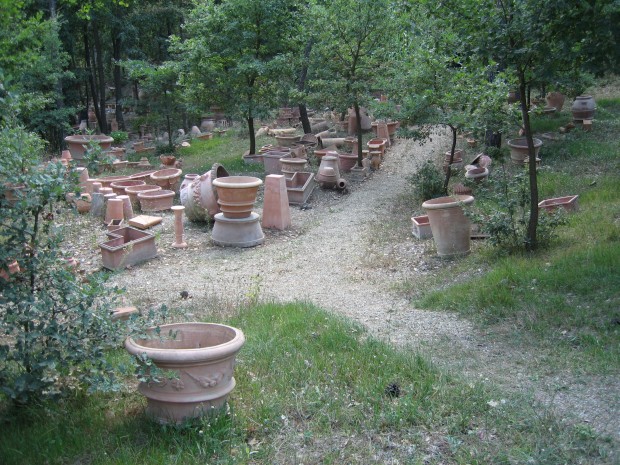





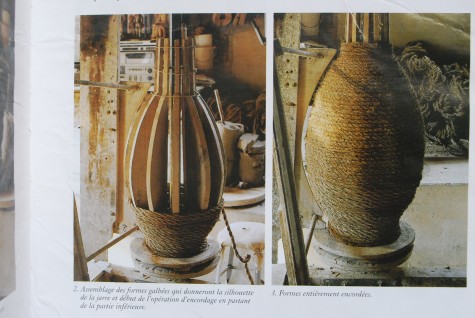

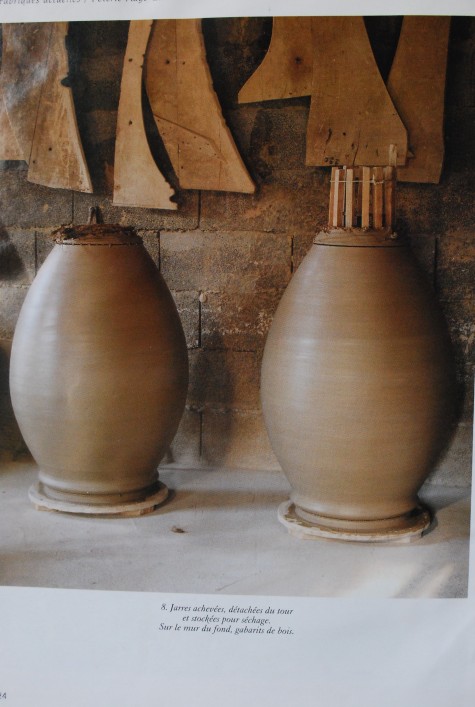



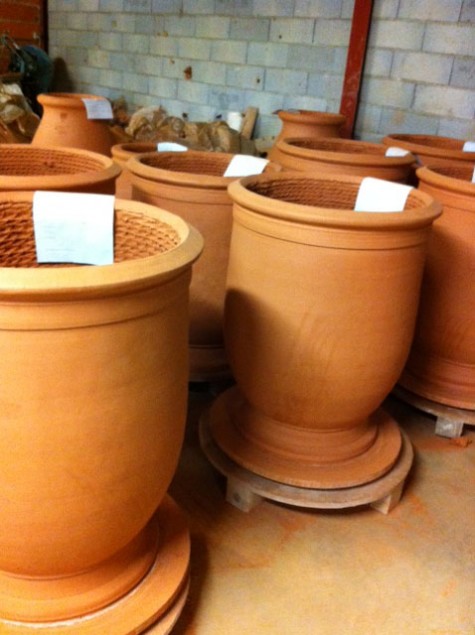





 In much the same way as I imagine the face of a person I have only talked to on the phone, I imagine plenty about Italy, based on these faces. This face, part cat, part lion, part sun, part satyr-what is the meaning behind those wrinkled brows, and intense gaze? I have my own mythology which I have enjoyed imagining.
In much the same way as I imagine the face of a person I have only talked to on the phone, I imagine plenty about Italy, based on these faces. This face, part cat, part lion, part sun, part satyr-what is the meaning behind those wrinkled brows, and intense gaze? I have my own mythology which I have enjoyed imagining.  Some faces of the women can recall the Italian paintings of the Renaissance. The modelling of the features of this face is quite extraordinarily soft and fluid. The contrast of this face, with the heft and solidity of the clay is beautiful.
Some faces of the women can recall the Italian paintings of the Renaissance. The modelling of the features of this face is quite extraordinarily soft and fluid. The contrast of this face, with the heft and solidity of the clay is beautiful.
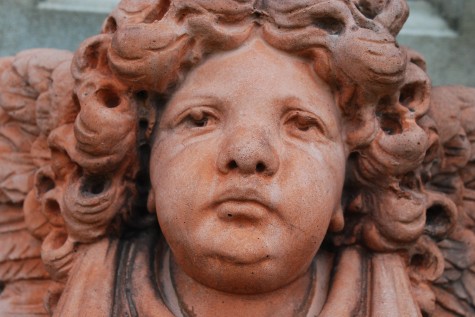 I see some of the history of Italian garden making and culture. This I get, before I ever fill them with dirt, and plant something in them. It also makes me careful about how I plant-so that a mature planting does not obscure what is represented on the pot.
I see some of the history of Italian garden making and culture. This I get, before I ever fill them with dirt, and plant something in them. It also makes me careful about how I plant-so that a mature planting does not obscure what is represented on the pot.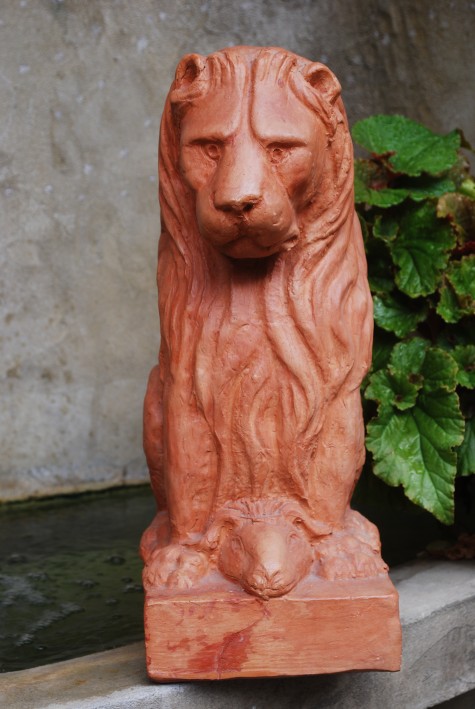
 I like so much that the women have strong faces. She seems able and willing, her eyes wide open. Those who love the surfaces of their contemporary pots take just as much pleasure as I do from mine; everyone to their point of view.
I like so much that the women have strong faces. She seems able and willing, her eyes wide open. Those who love the surfaces of their contemporary pots take just as much pleasure as I do from mine; everyone to their point of view.